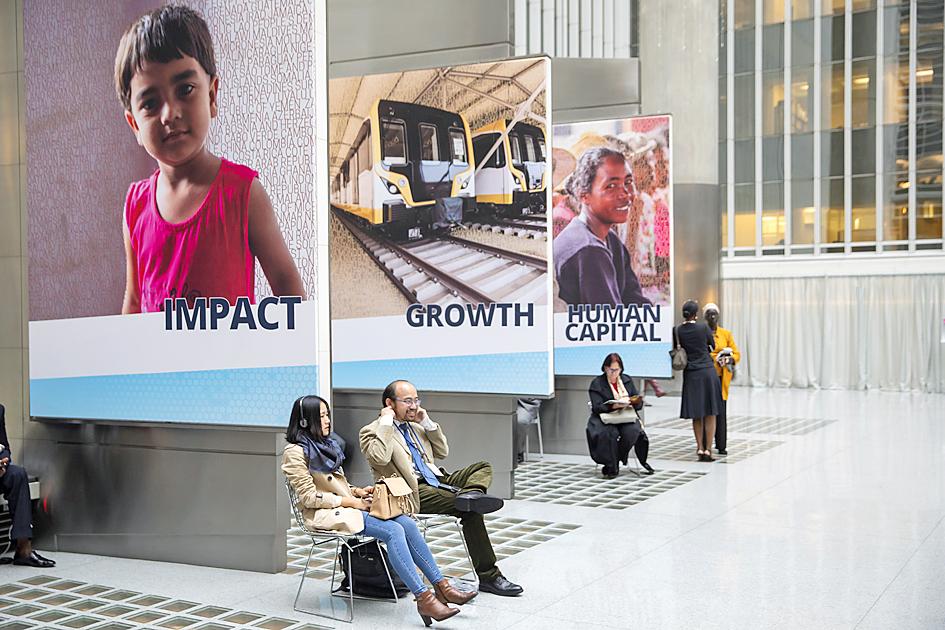World Bank chief economist Carmen Reinhart earlier this week said that the COVID-19 pandemic is turning into a major economic crisis and warned of the possibility of a financial crisis emerging.
“This did not start as a financial crisis, but it is morphing into a major economic crisis, with very serious financial consequences,” Reinhart said. “There’s a long road ahead.”
Reinhart, who took her new role in June, is best known for her work with Kenneth Rogoff, a professor at Harvard University, on the last financial crisis in their 2009 book This Time Is Different: Eight Centuries of Financial Folly.

Photo: EPA-EFE
It made the pair the go-to resource on the history of government defaults, recessions, bank runs, currency sell-offs, and inflationary spikes.
Asked whether central banks buying bonds to keep yields low is ultimately a zero-sum game when everyone is doing it, Reinhart said: “This is a war. During wars governments finance their war expenditures however they can, and right now there are dire needs.”
“The scenario we are in is not a sustainable one,” she added.
Reinhart made the remarks after the world’s richest nations agreed to renew a debt relief initiative for the poorest countries through at least the first half of next year, falling short of the World Bank’s call for a full-year extension.
China is owed almost 60 percent of the money that the world’s poorest nations would be due to repay this year, World Bank data showed.
It has made many loans to developing countries with terms that are not transparent and at higher interest rates than the nations can afford, World Bank president David Malpass said in August.
Asked about China not participating in the debt relief initiative, Reinhart said that Beijing was in fact involved, just “less than fully.”
The China Development Bank, a major lender, has not joined the effort, nor have private sector creditors, she said.
“Full participation is something we should strive for but unfortunately haven’t yet seen,” Reinhart added.

Shiina Ito has had fewer Chinese customers at her Tokyo jewelry shop since Beijing issued a travel warning in the wake of a diplomatic spat, but she said she was not concerned. A souring of Tokyo-Beijing relations this month, following remarks by Japanese Prime Minister Sanae Takaichi about Taiwan, has fueled concerns about the impact on the ritzy boutiques, noodle joints and hotels where holidaymakers spend their cash. However, businesses in Tokyo largely shrugged off any anxiety. “Since there are fewer Chinese customers, it’s become a bit easier for Japanese shoppers to visit, so our sales haven’t really dropped,” Ito

The number of Taiwanese working in the US rose to a record high of 137,000 last year, driven largely by Taiwan Semiconductor Manufacturing Co’s (TSMC, 台積電) rapid overseas expansion, according to government data released yesterday. A total of 666,000 Taiwanese nationals were employed abroad last year, an increase of 45,000 from 2023 and the highest level since the COVID-19 pandemic, data from the Directorate-General of Budget, Accounting and Statistics (DGBAS) showed. Overseas employment had steadily increased between 2009 and 2019, peaking at 739,000, before plunging to 319,000 in 2021 amid US-China trade tensions, global supply chain shifts, reshoring by Taiwanese companies and

Taiwan Semiconductor Manufacturing Co (TSMC) Chairman C.C. Wei (魏哲家) and the company’s former chairman, Mark Liu (劉德音), both received the Robert N. Noyce Award -- the semiconductor industry’s highest honor -- in San Jose, California, on Thursday (local time). Speaking at the award event, Liu, who retired last year, expressed gratitude to his wife, his dissertation advisor at the University of California, Berkeley, his supervisors at AT&T Bell Laboratories -- where he worked on optical fiber communication systems before joining TSMC, TSMC partners, and industry colleagues. Liu said that working alongside TSMC

TECHNOLOGY DAY: The Taiwanese firm is also setting up a joint venture with Alphabet Inc on robots and plans to establish a firm in Japan to produce Model A EVs Manufacturing giant Hon Hai Precision Industry Co (鴻海精密) yesterday announced a collaboration with ChatGPT developer OpenAI to build next-generation artificial intelligence (AI) infrastructure and strengthen its local supply chain in the US to accelerate the deployment of advanced AI systems. Building such an infrastructure in the US is crucial for strengthening local supply chains and supporting the US in maintaining its leading position in the AI domain, Hon Hai said in a statement. Through the collaboration, OpenAI would share its insights into emerging hardware needs in the AI industry with Hon Hai to support the company’s design and development work, as well